Greetings, book-eaters and treat lovers! Friends, I am trying my best to revel in all the things I love about this season, but the endless heat and endless summer is really starting to wear on me. Have you ever felt like winter will just never end? Like you’re going to lose it if you have to spend one more day inside because it’s just too cold and snowy to go out? Well, I never have, but I understand it, because that is how I feel right now. The 90 degree days make me want to cry. My body is done. My brain is done.
So, as a treat, let’s collectively celebrate winter! I have an ARC of The Other Mother by Rachel M. Harper to give away. (IT IS BRILLIANT.) Tell me in the comments something you love or are looking forward to about fall and/or winter. Everyone who comments will be entered into the giveaway. I’ll randomly select a winner next Wednesday.
I read The Faggots & Their Friends back in March and I’ve been waiting to tell you about it, maybe because it’s one of those books that I want to hold close to my heart and also toss into the air like confetti so that everyone can read it. It’s a book that embodies the idea of and — loss and delight, frivolity and care, performance and intention. It’s and and and — endless stories, endless windows, endless doorways, continuing and continuing and continuing.
This week’s books are all like that. In different ways, they’re about continuation and joining, about the ongoing links between now and later and before, about the limitlessness of and — and what it means to embrace that limitlessness.
The Books
Backlist: The Faggots & Their Friends Between Revolutions by Larry Mitchell, illustrated by Ned Asta (Fiction, 1977)
I talk a lot about how grateful I am to be living in the Golden Age of Queer Lit. There are so many amazing queer books coming out all the time, more than I ever dreamed possible when I was a baby gay teenager. Each one feels like a gift. And then, every so often, I read a book like this, and reading it feels like being enveloped in love from my queer ancestors. Books published today can’t give me this feeling. It’s a specific kind of experience, reading a book like this, a hard one to describe. I’m not sure I can describe it. I just know that I read it in an afternoon, and afterwards I felt both safer and sadder, more seen and more vulnerable. It felt like some fabulous, glittery beast had risen up out of the past on multicolored wings to carry me away, carry me back, carry me forward—or maybe just carry me for an afternoon, the book and me existing in some quiet place outside of time, where, for a moment, we are all free.
This book is silly and wise:
The rule is: You get more warm fuzzies by giving away all your own warm fuzzies. Keeping your warm fuzzies to yourself results in a large accumulation of cold prickles.
It’s about the ways that queer people take care of each other, the ways we must take care of each other:
At the end of the street sits a carved house with close-cropped lawns and discrete flower gardens. Here live a group known on the street as the Boys in the Backroom. They can put the fix in to help a friendly faggot in distress. They help protect the community from the dangers of the men. They can play all the men’s games, and the dirtier the better. They say they have, over many years, taught themselves to look, talk and act, although not feel, like the men. They did not learn this easily nor with great pleasure. But they learned it well.
It’s about solidarity:
The women who love women wrote a song for the faggots. It was called, "Anything you do that the men don't like is o.k. by us.”
It’s about the magic of queer community:
The strong women told the faggots that the more you share, the less you need. At first the faggots thought the strong women were being either obtuse or utopian. But as they began to share their clothes and their secrets and their magic potions and their spaces and their incantations and their animals and their books and their visions and their food, they learned, slowly, that the more they shared with each other, the more there was that could be shared and the less any one faggot needed.
It’s about queer joy:
The faggots are dressed for play, the queens are dressed to live in another world. They have allowed their tatters of tinsel and lace to turn them into fantastic creatures that the world has never seen before. On this one day, all the men play golf and leave the faggots and their friends alone to cavort and amuse each other in the streets of the devastated city.
And it’s about the history that we hold in our bodies, that is passed down from generation to generation in intimate conversations and spectacular theatrics:
The faggots cultivate the most obscure and outrageous parts of the past. They cultivate those past events which the men did not want to happen and which, once they did happen, they wanted to forget. These are the parts the faggots love the best. And they love them so much that they tell the old stories over and over and then they act them out and then, as the ultimate tribute, they allow their lives to re-create those obscure parts of the past. The pain of fallen women and the triumph of defeated women are constantly and lovingly made flesh again. The destruction of witty faggots and the militancy of beaten faggots are constantly and lovingly made flesh again. And so these parts of the past are never lost. They are imprinted in the bodies of the faggots where the men cannot go.
This book is a song, a psalm, a fierce and beautiful outpouring of love and mischief from our queer ancestors, a reminder and a reprimand, a sexy chorus of queer voices calling on us to love each other hard, hold each other close, and take our pleasure seriously. It's an absurd and irreverent dance, a praise cry, an urgent collection of hilarity and revelry and truth from those who came before, those who survived and those who didn't, from all the queer and trans ghosts and hauntings and wisps of memory, from the glamorous queens and dyke warriors and gentle boys, from all the good queer things that blossomed despite death and despair: that we can only rely on each other, that assimilation only ever makes us small, that there is no revolution without solidarity, that our truest, most glorious strength and beauty and creative possibility lies in community care and queer family.
This weird, imperfect little book, full of sex and tenderness, is queer ancestral healing. It will live inside my heart forever, beating its ferocious, loving reminder to listen deeply and take up space and offer what small queer gifts I have to this heartbreaking mess of a world.
Frontlist: Lost & Found by Kathryn Schulz (Memoir)
I listened to this exquisite memoir in one day earlier this summer, on a long drive and a long ferry ride, and then walking along the evening beach on my beloved island. It is a truly beautiful book. I suppose I say that about a lot of books, but this one feels beautiful to me in a particular way, the way sunlight on a wooden floor is beautiful, or water droplets on a daffodil on a cloudy day, or the cracked blue glaze of a beloved ceramic bowl. Old, comfortable, ordinary beauty. It’s an ode to world, to how much beauty the world holds, even—perhaps especially—in the midst of grief.
It’s split into three parts. The first is about the death of Schulz’s father, and the grief of afterward. The second is about falling in love with the woman who would become her wife. These two experiences occurred within eighteen months of each other, and so, for Schulz, they are linked both emotionally and spatially. The third part, “&” is about that linkage, about the history of the ampersand and about and as in idea, about what it means to tie words and thoughts and places and people together.
Schulz recounts these monumental experiences in her own life with gorgeous care and a striking attention to detail: colors and smells, the shapes of objects, a kiss, the dark cave of grief and depression, car rides, arguments, textures. But she also writes about what it means to lose something, to be lost, and what it means to find, to be found. It’s a memoir about losing and finding and losing again, and again and again and again. She takes these ideas to all sorts of interesting places and tells all sorts of interesting stories. At times she’s literal—lost objects, found objects. And at times she delves into the spiritual, the emotional, the intellectual—being lost within ourselves and others, existing as humans in the universe, how love finds us, how grief loses us.
I would recommend this book on the strength of the first two sections alone, but in the last section Schultz does something extraordinary in the way she writes about the intermingling of love and grief, and about language. She doesn’t tie the story up in a neat bow. Instead, by writing about and—that pesky little conjunction that does so much work, figuratively and literally, on the page and in our lives—she complicates the story. She makes it all bigger.
Grief is complicated. But happiness is complicated, too. Schultz’s writing about falling in love is rich and layered, full of nuance and complexity. Her wonderment is palpable, her joy sometimes incandescent. Yet I found these sections as hard to read at times as the heartbreaking sections about her father’s death. Schultz writes about happiness with the same intensity as she writes about grief. There’s an expansiveness in her approach that’s rare: everything, she seems to be saying, is worthy of our careful attention. Everything that’s lovely, everything that’s impossible, and all the mundane stuff in between.
Upcoming: Self-Made Boys by Anna-Marie McLemore (YA Historical Fiction, Feiwel & Friends, September 6th)
I love queer retellings, partly because they embody the idea of and. We’ve been blessed with a lot of them in the past few years. This is the second queer Gatsby retelling I’ve read recently—Siren Queen by Nghi Vo is the other one, which I enjoyed, though I can’t remember much about it now. The Great Gatsby coming into the public domain has been an absolute boon for queer retellings. I don’t have any particular attachment to the original, but it is just so ripe for queering! First of all, Nick and Gatsby are obviously gay for each other, and it’s always satisfying to see subtextual queer relationships made textual. Beyond that, there’s so much going on below the glitzy surface, so much room to explore race and class and gender and queerness in ways Fitzgerald didn’t. (I mean, right? I read the book in 2002. I don’t remember much.)
So in this version Nick is a seventeen-year-old Latine trans boy. He’s left his family back in Beet Patch, Wisconsin to join his cousin Daisy in New York. He’s secured a job on the stock exchange, and Daisy finds him a sweet little cottage to live in, thanks to her rich asshole almost-fiancé, Tom. Nick can’t wait to get to New York, to prove himself, to come into his manhood, to make enough money to send some back to his parents in thanks for everything they’ve done for him (especially for helping him live as the boy he always knew himself to be). But things in New York don’t go as planned.
First of all, Daisy is passing as white and won’t admit that he’s her cousin—she tells Tom he’s the son of her mother’s housekeeper. Yeah. Bad. Then there’s Nick’s mysterious neighbor, Jay Gatsby, who, Nick soon learns, is also trans. And he’s maybe the most beautiful boy Nick has ever seen. And he throws these lavish parties that are attended by—you guessed it—tons of queer and trans people. So what does Nick do? He falls in love with Gatsby, even though he’s pretty sure Gatsby’s in love with Daisy. He even agrees to help Gatsby woo Daisy, despite being pissed at Daisy because of the whole “you’re too brown to be my cousin” thing. It’s a whole mess.
This is such a warm, lovely book. It’s mostly a romance, and the romance is very sweet, but it’s also about Daisy and Nick and their complicated relationship, and all the ways their identities inform how they move through the world. It’s about being seen (by the right people, by the wrong people) and not being seen, about learning to see yourself, about learning to see other people. It’s about teenagers making mistakes and figuring out how to fix them. Nick and Daisy and Gatsby and Jordon (obviously queer too, everyone is queer) are all wrestling with how to exist in a world that, in different ways, doesn’t make space for them. McLemore is so attentive to all of these differences. And they’re so attentive, too, to the way these characters make space for themselves.
Gatsby and I may have been nothing to men like Tom Buchanan, but men like that did not know that we were as divine as the heavens. We were boys who had created ourselves. We had formed our own bodies, our own lives, from the ribs of the girls we were once assumed to be.
Nick and Gatsby (and, in different ways, Daisy and Jordan) are trying to figure out what it means to be self-made. How to make themselves. How to build themselves. They don’t have a lot of role models. Nick and Gatsby’s transness makes them self-made in a particular way. But over the course of the book, they both come to see the fallacies in the idea of being “self-made”, the loneliness of it. Nobody is truly self-made; we make each other. In the end, that’s what the four of them do: they work their way through hurt and misunderstanding and loss and distance to make each other whole.
Finally, I gotta give it to McLemore: they really went for it with the green light, and, in my opinion, nailed it.
The Bake
I know some people don’t like it, but I stan chocolate and orange. I am also forever in love with candied orange peel and would put it in everything if I could. Which is what I did the other day when I was craving chocolate cookies. These are rich and fudgy and wonderful, and if you aren’t into chocolate and orange, just replace the candied peel with nuts, or leave it out.
Decadent Chocolate Orange Cookies
Adapted from Molly O’Neill via NYT Cooking
I think this recipe made about 24 cookies but honestly? I just started eating them as soon as they came out of the oven and forgot to. count.
Ingredients
9 ounces bittersweet or semisweet chocolate, finely chopped, plus 6 ounces cut into smallish chunks
6 Tbs unsalted butter
2 egg
96 grams (7 Tbs) toasted sugar (As always, it’s fine to use non-toasted sugar)
1 1/2 tsp vanilla
73 grams (7 Tbs) all-purpose flour, sifted
1 teaspoon baking powder
250 grams (2 cups) candied orange peel, chopped
Flaky salt, for spinkling
Preheat the oven to 325 degrees. Line two cookie sheets with parchment paper or silicone baking mats. Place the finely chopped chocolate and butter in a heatproof bowl set over a pot of simmering water (aka a double boiler). Melt over medium heat, stirring frequently, until smooth. Remove from the heat and set aside to cool slightly.
In the bowl of a stand mixer fitted with the paddle attachment, or with handheld beaters, whip the eggs and sugar until the mixture has lightened in color, thickened, and increased in volume, about 10 minutes. Add the vanilla and melted chocolate and mix until smooth. Add the flour and baking powder and mix again. Finally, add the chocolate chunks and candied peel, and mix just until everything is combined.
Drop heaped spoonfuls of batter onto the prepared cookie sheets, leaving about 1 1/2 inches between them. Sprinkle with flaky salt. Bake until the cookies are puffed and the tops are starting to crack, but the centers are still gooey, 10-14 minutes. Let cool on the cookie sheets.
The Bowl and The Beat
The Bowl: Roasted Corn & Onions with Garlicky Pork Meatballs
Roasted corn is one of my favorite, favorite things. Many vegetables are improved with roasting, but corn is especially well suited to it. It just gets so sweet and perfect. The pork meatballs go beautifully with this mix of roasted summer veggies, and make it a satisfying meal, but you don’t have to bother with them if you don’t want to.
Cut the kernels off some corn. I used 6 ears. Slice 2-3 onions into big wedges. Cut some tomatoes into quarters. I used sauce tomatoes, four or five, which roast beautifully and aren’t too juicy. Whole or havled cherry tomatoes would work well too. Toss it all on a baking pan with olive oil, salt and pepper, some whole cumin and fennel seeds, and a sprinkling of Aleppo pepper. Roast at 450 for 40ish minutes, until all the veggies are beautifully brown and caramelized.
Meanwhile, make the meatballs. In a large bowl, combine a pound of pork, a handful of panko or breadcrumbs, an egg, a bunch of pressed garlic cloves (at lest 5 if you’re like me), a small chopped onion or shallot, salt and pepper, and any herbs or spices you feel like. Form little balls with your hands, arrange them on a baking tray, and bake at the same temperature as the veggies for 10-15 minutes, until they’re cooked through and browned on the bottoms.
Pile it all into a bowl and dig in. This would be delicious with a minty yogurt sauce or some crumbled mild cheese.
The Beat: The Holiday Trap by Roan Parrish, read by Natalie Duke, Pete Cross, and Hillary Huber
Oh, this is lovely so far and exactly what I needed. I usually enjoy Roan Parrish’s romances, and this seems to be a double romance plus. Greta is desperate to escape her meddling family and small Maine hometown. Truman is desperate to escape New Orleans, having just discovered that his boyfriend of almost a year has a husband and kid he didn’t know about. So, on the advice of a mutual friend, they swap houses for a month. Greta will take care of Truman’s dog Horse, and Truman will take care of Greta’s many, many plants. I laughed so many times in the first chapter! It’s very warm and silly and, of course, on his second day in town Truman meets a dreamy florist who assures him he hasn’t just killed one of Gerta’s beloved plants, and Greta meets a glamorous mathematical genius with a miniature pony named Teacup who takes her on an impromptu tour of the city that ends in an oyster dinner. Where is my holiday trap? Who wants to swap houses with me for a month? I’m happily accepting offers from anyone who lives about the 50th parallel north.
The Bookshelf
A Picture
Here’s a glimpse into my chaotic coffee table book stacks: books I’ve been reading slowly for months, books I’ve just started, library books due soon so they're up next, books I was planning to start this weekend but didn’t actually get around to…
Bonus Recs that Embody And
Monster Portraits by Sofia Samatar and Del Samatar is a weird and beautiful little book full of ands. So is Aug 9—Fog by Kathryn Scanlan. I may review this one at some point, but in case I don’t, it’ll take you about 20 minutes to read and it is both charming and moving.
The Boost
Do you do that thing where you save a bunch of stuff to read in your inbox or the reading list in your browser or the notes app on your phone or wherever you put digital stuff to come back to later? Well, I do. I am bad at reading things that aren’t books, so I often save articles until I have a whole pile and then settle in. Here’s a peek into my pile:
Callum Angus, “Soft and Dangerous”: on needles and art and hope and despair and being trans right now.
Kayla Kumari Upadhyaya’s gorgeous review of my favorite favorite novel, All This Could Be Different.
A fantastic interview between Sarah Thankam Mathews (author of said novel!) and novelist Sanjena Sathian.
I raved about Shola von Reinhold’s Lote a few weeks ago. This is a brilliant, beautiful review that highlights so much of what I loved (and am still thinking about) in the book.
I guess books are on my mind. Here’s something else, just for fun. (To be fair, my fascination stems from a recent read, which I will hopefully be reviewing soon!)
As always, a little bit of beauty to send you on your way: I’ll start with the winter joy. Here’s where I wish I was. The snow, the clouds, the shades of brown and white, the cold expansiveness, the quiet, the sharp freshness, the dark hills. I can almost taste it.
Catch you next week, bookish friends!





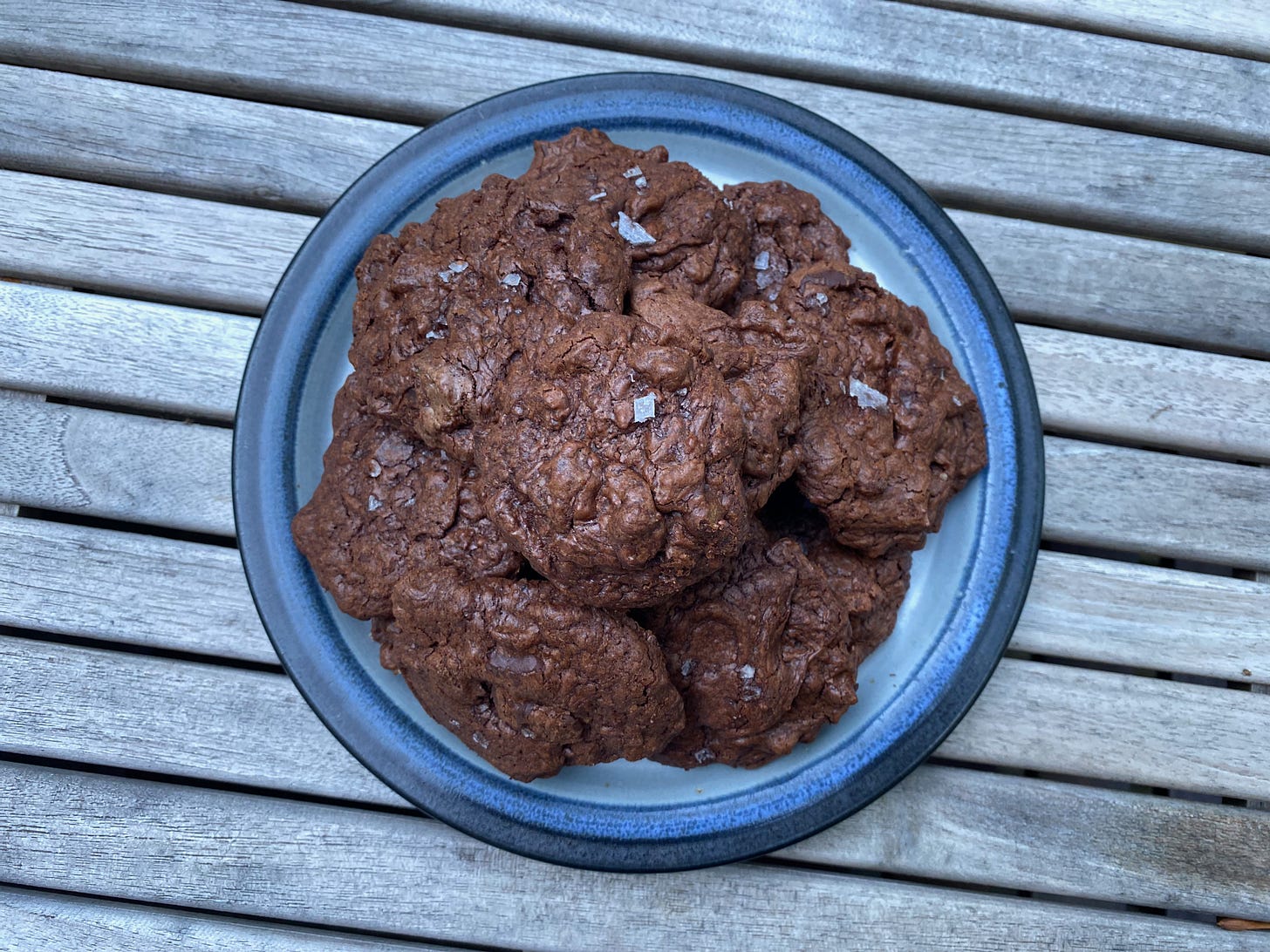
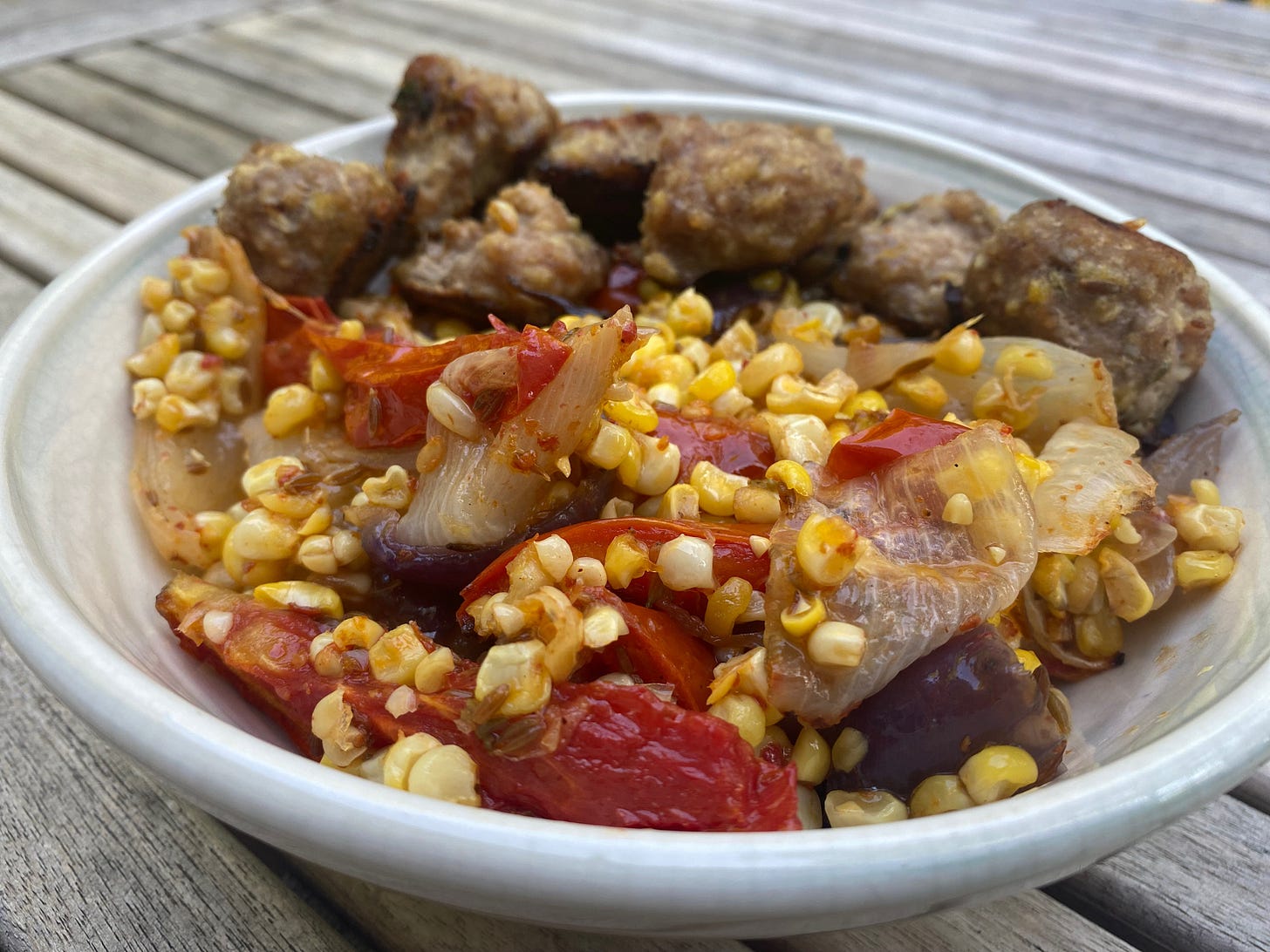
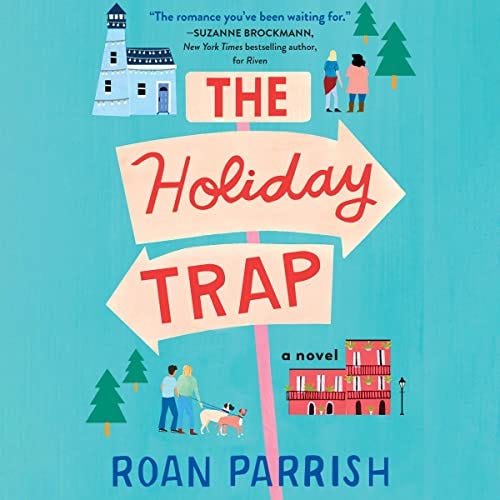
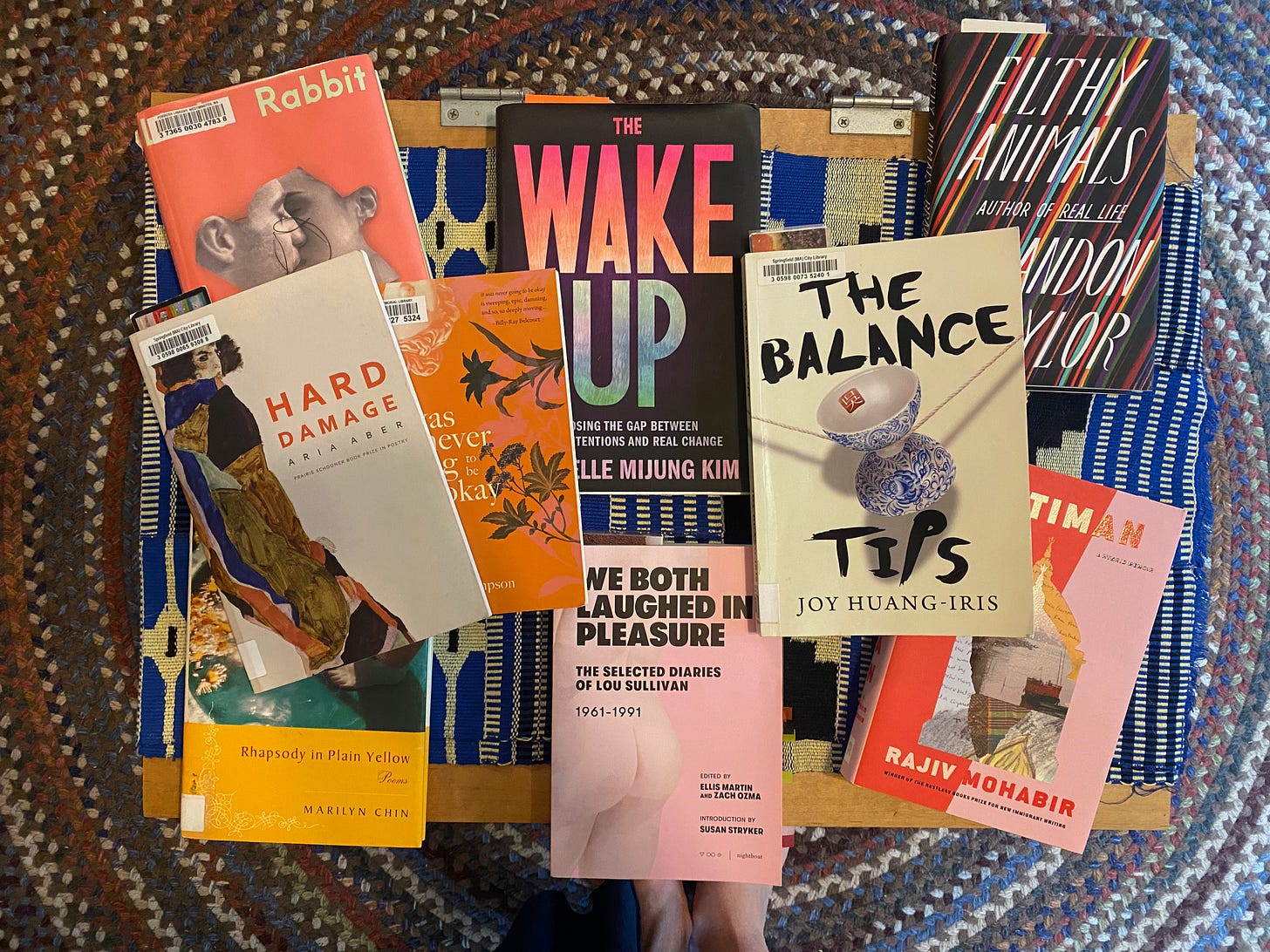
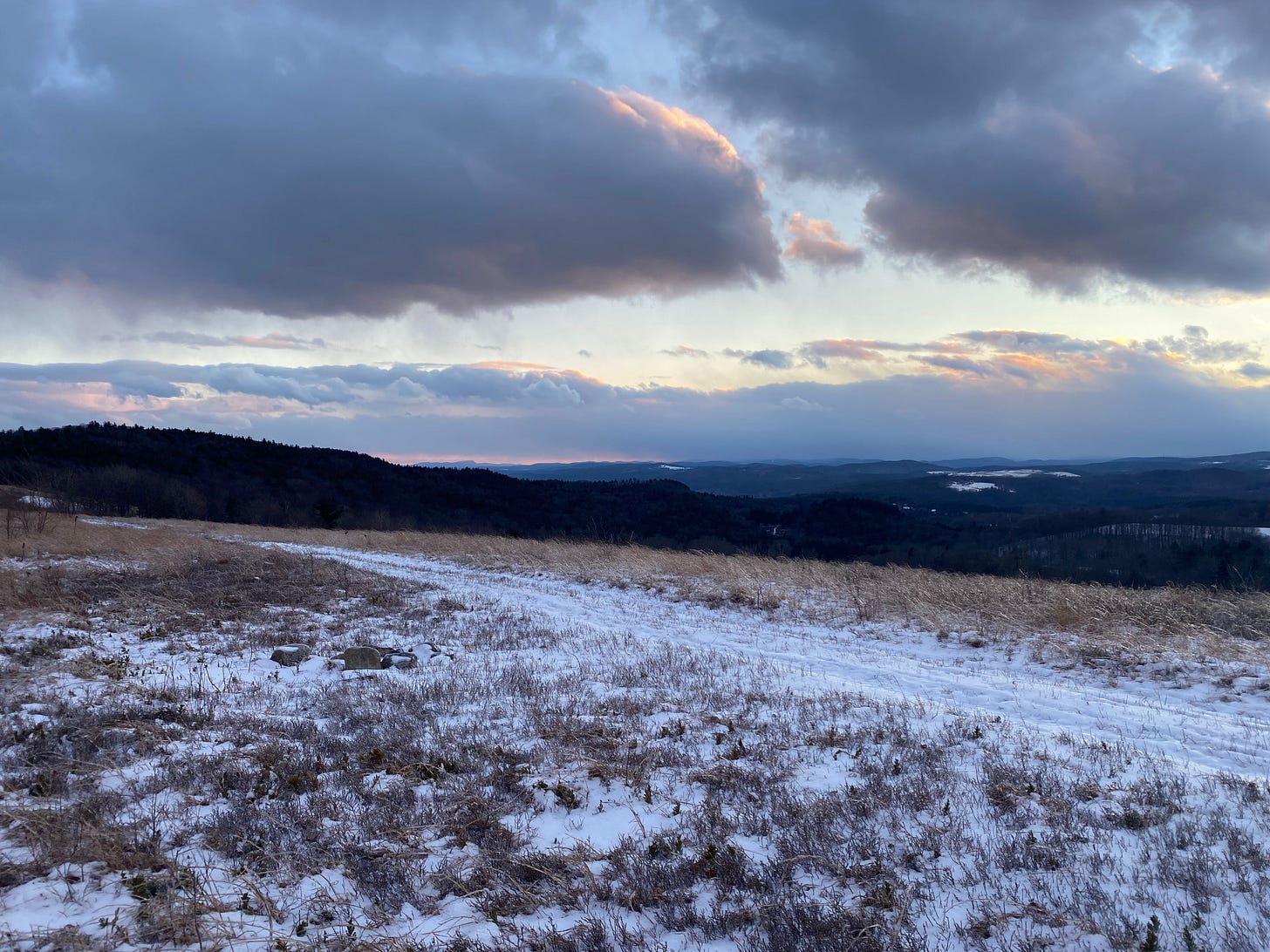
I am so ready to have cooler temperatures. I'm a knitter, and I want to be wearing all the cozy wool socks I've been knitting, and enjoy my handmade blankets and sweaters. Oh, and dear lord it would be great to drink coffee or tea HOT without feeling like my insides (and outsides) are melting. I'd also like to bake without heating up the whole house.
I am looking forward to a December of cookie content! :)